Ouagadougou is the capital of Burkina Faso. Often shortened to Ouaga, the city is the administrative, communications, and economic center of Burkina Faso and a vibrant cultural hub.

The city is known for hosting the Panafrican Film and Television Festival of Ouagadougou (FESPACO), the biggest film festival in Africa, held every two years. Ouagadougou is also home to the National Museum of Burkina Faso and several other cultural and educational institutions.
Where is Ouagadougou?
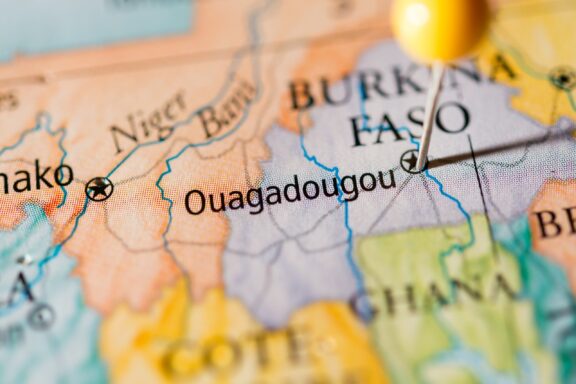
Ouagadougou occupies the central location in Burkina Faso, a landlocked country in West Africa. The city lies on the central plateau, characterized by flat terrain and savanna grasslands.
The geographical coordinates of Ouagadougou are approximately 12.3714 °N latitude and 1.5197 °W longitude. The city is about 305 meters (1,000 feet) above sea level.
It’s also situated about 150 kilometers (93 miles) west of the country’s eastern border with Niger and roughly 250 kilometers (155 miles) southeast of the northern border with Mali.
History of Ouagadougou
Ouagadougou, initially an insignificant tribal settlement, was established in the 11th century and became the capital of the Mossi Empire under the reign of Emperor Oubri around the 15th century. During this time, the city grew in importance and prominence, becoming a regional trade and culture center.
The city was repeatedly invaded in the 18th century, first by the Jula people and later by the Fulani Empire. However, the Mossi managed to regain control of Ouagadougou each time.
In the late 19th century, the city fell under French control when Burkina Faso, then known as Upper Volta, was colonized. This period of colonial rule shaped much of the city’s infrastructure and urban planning, and the influence can still be seen today.
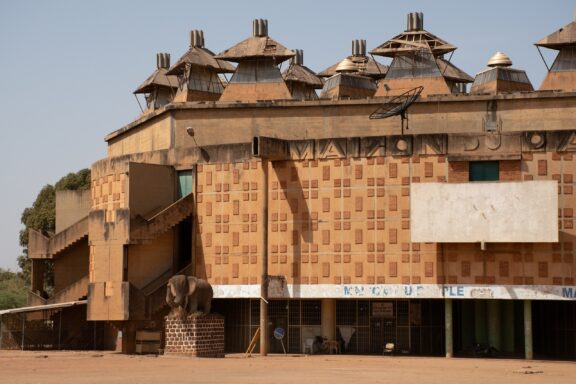
Burkina Faso achieved independence from France in 1960, and Ouagadougou became the capital of the newly independent nation. It has remained the political and administrative hub of the country ever since, despite periods of political instability and changes in governance.
Recently, Ouagadougou has been the site of protests and uprisings, particularly in 2014 when a popular revolt ousted President Blaise Compaoré, who had been in power for 27 years. The city has also grappled with substantial safety concerns stemming from regional instability and actions of extremist factions in the Sahel region.
Despite the challenges, Ouagadougou hosts several meaningful events today and continues to be a vital cultural and economic hub in Burkina Faso and the broader West African region.
Features of Ouagadougou
Ouagadougou is a city of contrasts – a bustling metropolis steeped in tradition, facing challenges but showing resilience and vitality.
Geography and Climate
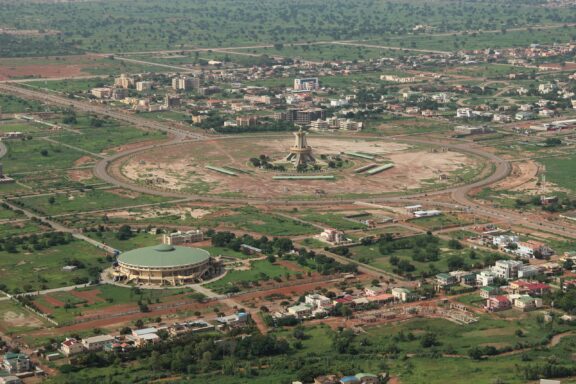
Ouagadougou is located in the center of Burkina Faso. The city lies in a tropical savanna zone with two distinct seasons: wet and dry.
The rainy season usually runs from May to October, with the heaviest rainfall in August. The rest of the year is dry, characterized by the Harmattan wind, which blows from the Sahara Desert, often dusting the city.
Temperatures in Ouagadougou can vary widely. The average high temperature during the hot season, which generally runs from February to May, can exceed 40 °C (104 °F). In the cooler months, from November to January, average high temperatures are usually in the high 20s to low 30s degrees Celsius (mid-80s to low 90s Fahrenheit).
Population
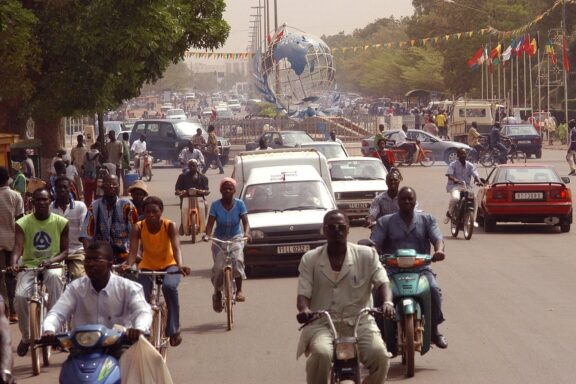
With a population exceeding 2.4 million, Ouagadougou is the most populous city in Burkina Faso. The city is home to many different ethnic groups, including the Mossi, the dominant ethnic group in Burkina Faso, but also many other groups from across the country and neighboring countries.
The official language of Burkina Faso is French, but many people in Ouagadougou also speak local languages, notably Moore, the language of the Mossi people. As a cosmopolitan city, Ouagadougou is characterized by a mix of traditional and modern lifestyles.
Economy
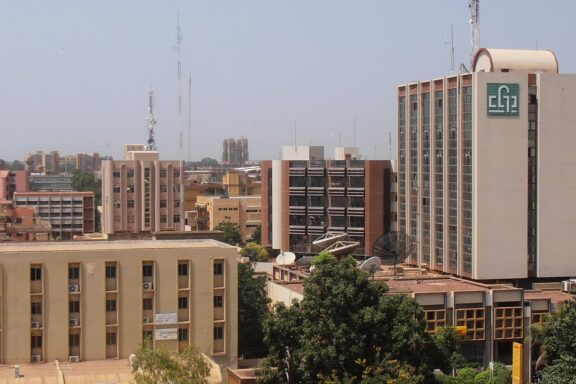
The economy of Ouagadougou is diverse and dynamic. The city is a major hub for trade and commerce in Burkina Faso and West Africa. The city has a vibrant marketplace and several shopping centers, with traders selling various goods.
Ouagadougou also has several industrial zones, with companies involved in food processing, textiles, and other forms of manufacturing. The city is a significant transportation hub, with an international airport and rail links to Abidjan in Côte d’Ivoire.
Despite these economic activities, Ouagadougou faces significant financial challenges like the rest of Burkina Faso. The city has high unemployment and underemployment rates, particularly among the youth. Moreover, the ongoing security issues in the region have also affected economic activity in the city.
It’s worth noting that Ouagadougou is also home to several international organizations and diplomatic missions, which also contribute to the local economy.
Things to Do and Places to See in Ouagadougou
It’s advised to refrain from traveling to Ouagadougou and Burkina Faso due to concerns about terrorism, criminal activity, and potential kidnapping risks. Nonetheless, if your circumstances necessitate a visit, or if you choose to proceed, here are the city’s most highly recommended sights and destinations:
1. Monument of National Heroes
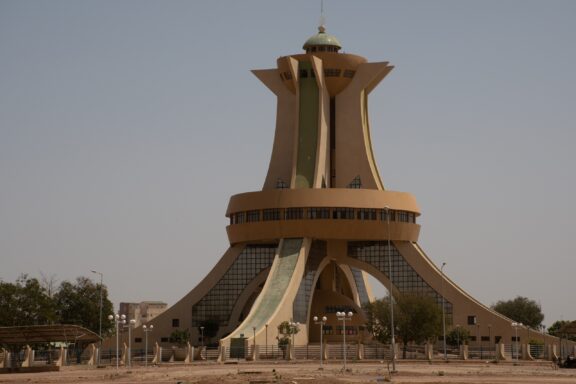
The Monument of National Heroes, also known as the Monument aux Héros Nationaux, is a significant landmark in Ouagadougou. It was erected in memory of those who fought for Burkina Faso’s independence. The monument is an important symbol of national pride and a focal point for celebrations and commemorations.
2. Ouagadougou Cathedral
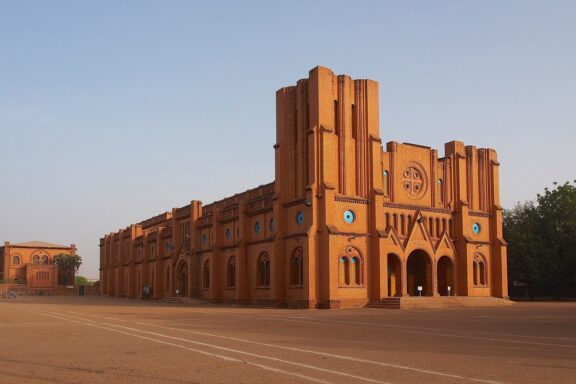
Also known as the Cathedral of the Immaculate Conception of Ouagadougou, this is the largest Cathedral in the city and one of the oldest, consecrated in 1934. It is a notable example of colonial-era architecture and serves as the seat of the Metropolitan Archdiocese of Ouagadougou. With its towering twin spires, the Cathedral is a significant landmark in the city.
3. Grande Mosquée de Ouagadougou
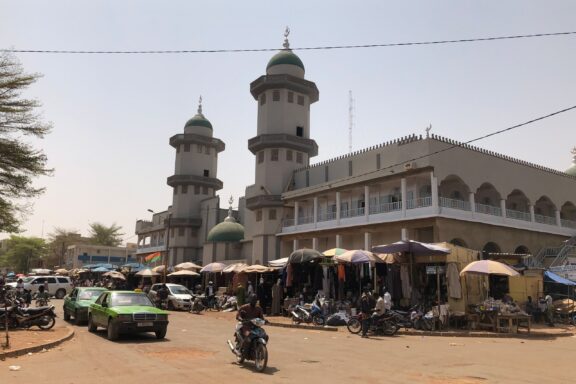
The Grand Mosque of Ouagadougou is one of the city’s most important Islamic religious sites. It is a beautiful example of Sudano-Sahelian architecture, with its earthen walls and wooden support beams. While it serves as a place of worship for Ouagadougou’s Muslim community, it is also an important cultural and architectural landmark in the city.
4. Canal Olympia
Canal Olympia is a modern cultural and entertainment venue in Ouagadougou, part of a network of venues across Africa built by the Vivendi Group. It offers a variety of programming, including film screenings, live music, and other performances. The venue also aims to promote local artists and cultural production.
Frequently Asked Questions
What is the currency in Ouagadougou?
The currency of Burkina Faso, including Ouagadougou, is the West African CFA franc (XOF).
When is the best time to visit Ouagadougou?
The best time to visit Ouagadougou is generally during the cooler months, from November to February. The weather during this period is relatively cool and dry, making it more comfortable for sightseeing and other outdoor activities.
What is the traditional food like in Ouagadougou?
The culinary heritage of Burkina Faso, reflected in Ouagadougou’s traditional cuisine, prominently features staple grains such as millet and sorghum, complemented by sauces prepared with indigenous ingredients. A range of characteristic dishes to savor include:
• Tô: A type of porridge frequently consumed in the region.
• Ragout d’Igname: A hearty yam stew that showcases local flavors.
• Bouilli de Riz: A rice-based dish with a unique preparation.
• Riz Gras: Also known as “Fat Rice,” this traditional dish is a delicious blend of rice cooked with tomatoes, onions, various spices, and often includes meat.
What’s a must-try dish/food in Ouagadougou?
One must-try dish in Ouagadougou is “Poulet Bicyclette,” a local chicken dish marinated in spices and then grilled or fried. The chicken used is usually free-range, giving it a unique taste.
Is it safe to visit Ouagadougou?
Burkina Faso faces significant security challenges due to regional instability and the activities of extremist groups. These risks include terrorism, crime, and kidnapping. It’s recommended that travelers check with their local embassy or consulate and consider these risks carefully before deciding to travel to Ouagadougou.
How can I get around in Ouagadougou?
Ouagadougou has several options for getting around, including taxis and auto-rickshaws known as “taxi-brousse” or “taxi-be.” There are also minibuses, or “dina,” for public transportation.
For longer distances, there are bus and rail links to other parts of Burkina Faso and neighboring countries. However, travelers should be aware that traffic can be heavy, and road conditions may vary.
Final Thoughts
Ouagadougou is a vibrant city boasting a rich cultural and historical tapestry that appeals much to the adventurous traveler. The city offers a blend of traditional and contemporary African experiences, from its bustling markets and fascinating museums to its architectural landmarks’ grandeur and thriving arts scene.
Despite the ongoing safety issues, its people’s spirit of resilience and warmth shines through, making it a captivating destination for those willing.
Image Sources and Copyright Information
- image-109: © Mappr
- Map Pinpointing Ouagadougou in Burkina Faso: © Tudoran Andrei/Shutterstock
- Maison du Peuple Building in Ouagadougou: © Anne Czichos/Shutterstock
- Aerial View of a National Heroes Monument and Surrounding Landscape: © Thierry Boitier/Shutterstock
- Locals Commuting in Ouagadougou City Center: © Helge Fahrnberger/Wikimedia | CC BY-SA 3.0 Unported
- Urban Landscape of Ouagadougou Administrative Center: © Wendkouni/Wikimedia | CC BY-SA 4.0 International
- Monument of National Heroes in Ouagadougou: © Anne Czichos/Shutterstock
- Sunset View of Ouagadougou Cathedral: © Sputniktilt/Wikimedia | CC BY-SA 3.0 Unported
- Street View of the Grand Mosque of Ouagadougou with Market Stalls: © Anne Czichos/Shutterstock